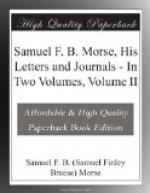This letter, to the best of my knowledge, has never before been published, and yet it contains statements of the utmost interest. The discovery of duplex telegraphy, or the possibility of sending two or more messages over the same wire at the same time has been credited by various authorities to different persons; by some to Moses G. Farmer in 1852, by others to Gintl, of Vienna, in 1853, or to Frischen or Siemens and Halske in 1854. Yet we see from this letter that Morse and his assistant Dr. Fisher not only made the discovery ten years earlier, in 1842, but demonstrated its practicability to the scientists and others in Washington at that date. Why this fact should have been lost sight of I cannot tell, but I am glad to be able to bring forward the proof of the paternity of this brilliant discovery even at this late day.
Still another scientific principle was established by Morse at this early period, as we learn from this letter, and that is the possibility of wireless telegraphy; but, as he has been generally credited with the first suggestion of what has now become one of the greatest boons to humanity, it will not be necessary to enlarge on it.
A brighter day seemed at last to be dawning, and a most curious happening, just at this time, came to the inventor as an auspicious omen. In stringing his wires between the two committee rooms he had to descend into a vault beneath them which had been long unused. A workman, who was helping him, went ahead and carried a lamp, and, as he glanced around the chamber, Morse noticed something white on a shelf at one side. Curious to see what this could be, he went up to it, when what was his amazement to find that it was a plaster cast of that little statuette of the Dying Hercules which had won for him the Adelphi Gold Medal so many years before in London. There was the token of his first artistic success appearing to him out of the gloom as the harbinger of another success which he hoped would also soon emerge from behind the lowering clouds.
The apparently mysterious presence of the little demigod in such an out-of-the-way place was easily explained. Six casts of the clay model had been made before the original was broken up. One of these Morse had kept for himself, four had been given to various institutions, and one to his friend Charles Bulfinch, who succeeded Latrobe as the architect of the Capitol. A sinister fate seemed to pursue these little effigies, for his own, and the four he had presented to different institutions, were all destroyed in one way and another. After tracing each one of these five to its untimely end, he came to the conclusion that this evidence of his youthful genius had perished from the earth; but here, at last, the only remaining copy was providentially revealed to the eyes of its creator, having undoubtedly been placed in the vault for safe-keeping and overlooked. It was cheerfully returned to him. By him it was given to his friend, the Reverend E. Goodrich Smith, and by the latter presented to Yale University, where it now rests in the Fine Arts Building.




